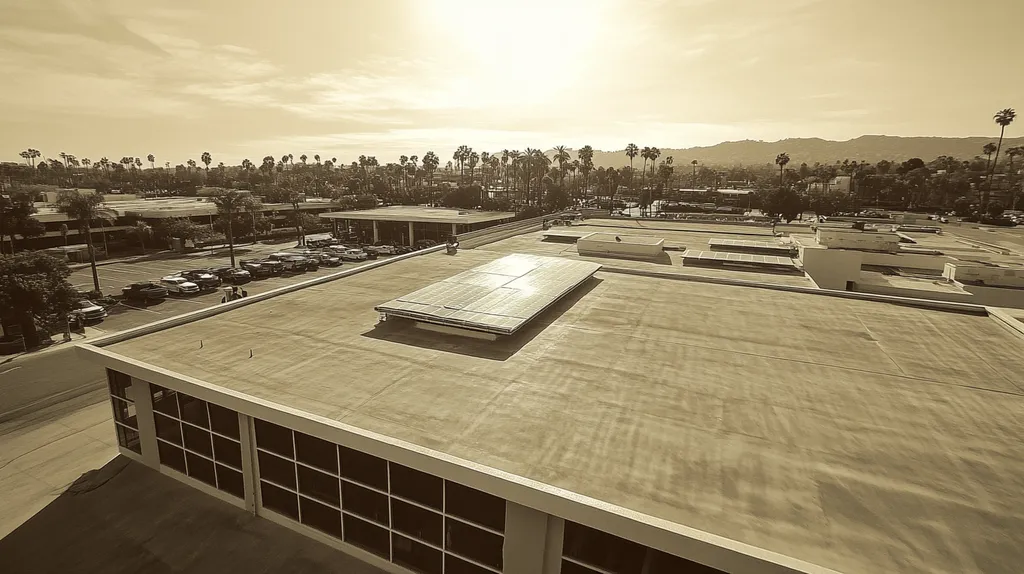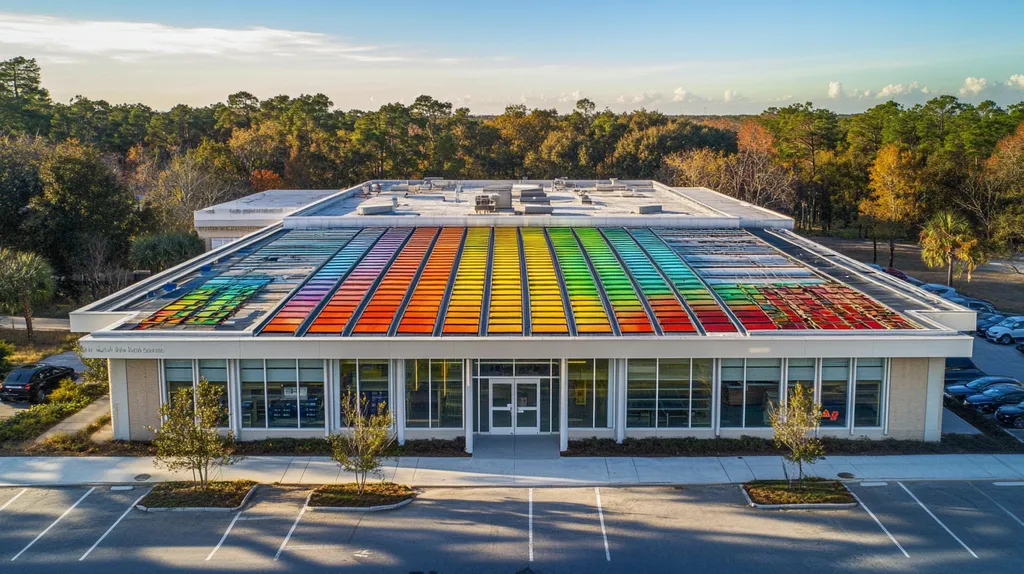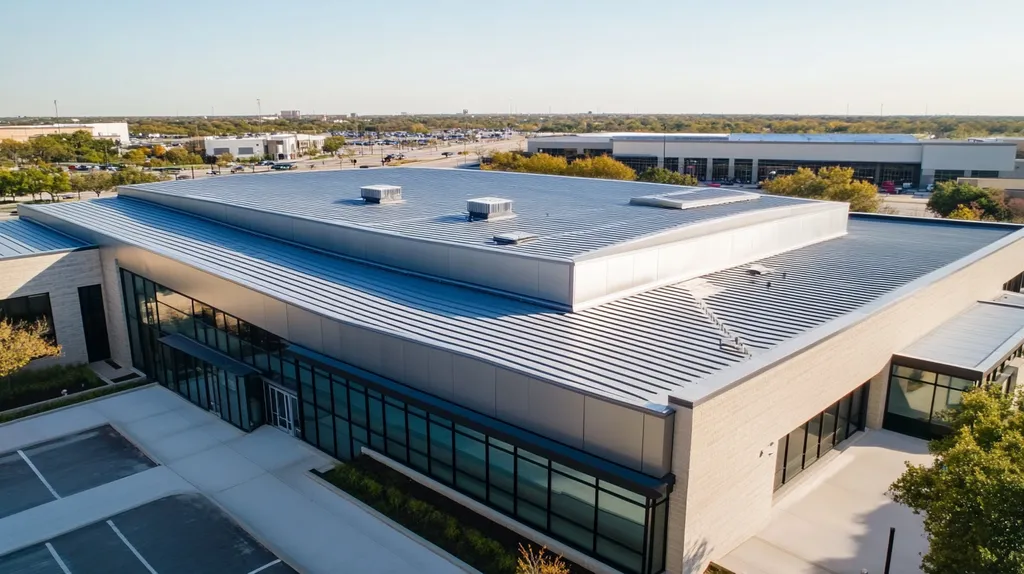Welcome to today’s Battle Royale featuring two roofing heavyweights: “Preventive Maintenance” in the east corner versus “Reactive Maintenance” in the west!
Tonight’s showdown pits these contenders against each other across six punishing rounds designed to test every aspect of their performance for HVAC System Maintenance for Industrial Roofs.
At stake? Millions in potential costs, decades of building protection, and the critical performance demands of modern commercial and industrial facilities.
Our professional judging panel will evaluate each round on technical merit, real-world performance, and value delivery. After all six rounds, we’ll declare our ultimate champion.
Ladies and gentlemen, facility managers and building owners… it’s time to rumble!
ROUND 1: INITIAL COSTS & INSTALLATION
When HVAC systems fail on industrial roofs, the impact can cascade through entire operations, potentially costing thousands in emergency repairs and lost productivity. The difference between smooth operations and costly disruptions often comes down to initial maintenance decisions. Each season brings unique challenges to rooftop HVAC systems, making the choice between preventive and reactive maintenance strategies crucial for long-term facility management.
Material Expenses
Preventive maintenance requires a structured investment in high-quality filters, belts, lubricants, and cleaning supplies. These materials are selected specifically for their durability and compatibility with existing systems, ensuring optimal performance through regular maintenance intervals.
Each season brings its own set of HVAC maintenance requirements, from spring cooling system checks to fall heating system preparation. Annual comprehensive assessments help identify potential issues before they become costly problems. (source: MGT Mechanical Ltd)
Reactive maintenance often relies on emergency sourcing of replacement parts, frequently at premium prices. This approach can lead to using whatever materials are immediately available, rather than optimal components for long-term performance.
With preventive maintenance offering predictable material costs and superior component selection, it claims a clear “ADVANTAGE” in material expenses compared to reactive maintenance’s higher emergency costs.
Installation Complexity
Preventive maintenance follows a systematic approach, with scheduled inspections and replacements performed during planned downtime. This method allows for proper preparation, appropriate staffing, and thorough completion of all maintenance tasks.
The organized nature of preventive maintenance enables technicians to work methodically, ensuring all components are properly installed and tested. Regular maintenance also helps identify potential installation issues before they become critical failures.
Reactive maintenance often involves rushed installations under emergency conditions. These hurried repairs can lead to improper installation, overlooked secondary issues, and increased likelihood of follow-up problems.
Given the controlled environment and systematic approach of preventive maintenance versus the chaos of emergency repairs, preventive maintenance claims the “ADVANTAGE” in installation complexity.
Project Timeline
Preventive maintenance operates on a predetermined schedule, allowing facility managers to plan around peak operational periods. This approach minimizes disruption to daily operations and ensures adequate resource allocation.
Regular maintenance intervals can be scheduled months in advance, enabling proper coordination with all stakeholders. This predictability allows for efficient resource allocation and minimal impact on facility operations.
Reactive maintenance timelines are inherently unpredictable, often requiring immediate attention regardless of operational impact. Emergency repairs can extend far beyond initial timeline estimates due to parts availability and cascading system issues.
The controlled, predictable nature of preventive maintenance versus the unpredictable, often extended timelines of reactive maintenance gives preventive maintenance the clear “ADVANTAGE” in project timeline management.
ROUND 1 WINNER: Preventive Maintenance
ROUND 2: DURABILITY & LIFESPAN
Industrial rooftop HVAC systems represent substantial capital investments that demand careful maintenance strategies. Industry data shows that properly maintained systems can operate efficiently for 15-20 years, while neglected units may fail in half that time. The choice between preventive and reactive maintenance significantly impacts both immediate performance and long-term equipment survival.
Impact on Equipment Durability
Durability in rooftop HVAC systems depends heavily on consistent maintenance of critical components. These include compressors, heat exchangers, and electrical systems that face constant exposure to weather extremes and operational stress.
Preventive maintenance programs implement regular inspections, cleaning schedules, and component replacements before failure occurs. This systematic approach helps maintain optimal operating conditions and prevents accelerated wear on vital parts.
Reactive maintenance typically allows minor issues to develop into major problems. When components run to failure, they often damage connected systems, creating a domino effect of equipment deterioration.
Given these factors, preventive maintenance claims a clear ADVANTAGE in equipment durability.
Influence on Equipment Lifespan
The operational lifespan of rooftop HVAC systems directly correlates with maintenance practices. Regular maintenance extends equipment life through early problem detection and systematic component care.
Preventive maintenance includes monthly tasks like filter replacement, quarterly thermostat testing, and annual comprehensive assessments that optimize system longevity. This structured approach helps identify potential issues before they impact system performance. (source: MGT Mechanical Ltd)
Reactive maintenance often results in shortened equipment lifespan due to accumulated stress on components. Emergency repairs frequently focus on immediate fixes rather than addressing underlying system health.
Therefore, preventive maintenance demonstrates a clear ADVANTAGE in extending equipment lifespan.
Cost Implications of Durability and Lifespan
Long-term cost control depends heavily on maintaining HVAC system integrity. Equipment replacement costs can reach six figures for large industrial installations, making durability and lifespan critical financial considerations.
Preventive maintenance creates predictable expenses through scheduled service intervals. This approach reduces emergency repair costs and allows for better budget planning.
Reactive maintenance typically generates higher lifetime costs through emergency service premiums and shortened replacement cycles. Unplanned downtime adds significant indirect costs through lost productivity.
The financial benefits of preventive maintenance earn it a clear ADVANTAGE in cost implications.
ROUND 2 WINNER: PREVENTIVE MAINTENANCE
ROUND 3: PERFORMANCE FACTORS
When HVAC systems underperform on industrial roofs, the consequences ripple throughout the entire facility. Studies show that poorly maintained rooftop units can consume up to 40% more energy than well-maintained systems, while operating at reduced capacity. This inefficiency impacts not just utility costs, but also workplace comfort, productivity, and equipment longevity.
Efficiency and Energy Consumption
Rooftop HVAC systems face unique challenges due to their exposed location and limited accessibility. Without regular attention, these units accumulate dirt, debris, and wear that severely impact their performance.
Preventive maintenance includes regular cleaning, calibration, and component checks that keep systems running at peak efficiency. These scheduled interventions ensure proper airflow, reduce strain on mechanical components, and optimize energy consumption.
Reactive maintenance typically allows systems to degrade until problems become obvious. By then, units are often running far below optimal efficiency, consuming excess energy while delivering reduced performance. (source: CareTemp)
With its focus on maintaining peak performance, preventive maintenance claims the clear “ADVANTAGE” in efficiency and energy consumption.
System Reliability and Uptime
In industrial settings, HVAC system reliability directly impacts operational continuity. Even brief outages can disrupt production processes, affect product quality, and create uncomfortable or unsafe working conditions.
Preventive maintenance establishes a systematic approach to identifying and addressing potential failures before they occur. This proactive strategy includes regular inspections, testing, and component replacement based on manufacturer specifications.
Reactive maintenance leaves systems vulnerable to sudden failures, often at the most critical times. These unexpected breakdowns frequently result in extended downtime while emergency repairs are arranged.
Given its role in preventing disruptions, preventive maintenance earns the “ADVANTAGE” in system reliability and uptime.
Performance Monitoring and Control
Effective HVAC performance requires consistent monitoring and control adjustments. Modern systems generate extensive operational data that can reveal emerging issues before they affect performance.
Preventive maintenance programs incorporate regular performance monitoring, trend analysis, and proactive adjustments. This data-driven approach helps optimize system operation while identifying potential problems early.
Reactive maintenance typically lacks systematic monitoring, making it impossible to detect gradual performance degradation. Problems often go unnoticed until they cause significant operational issues.
The comprehensive monitoring approach of preventive maintenance secures the “ADVANTAGE” in performance monitoring and control.
ROUND 3 WINNER: PREVENTIVE MAINTENANCE
ROUND 4: MAINTENANCE REQUIREMENTS
Industrial rooftop HVAC maintenance failures can paralyze operations and create devastating financial impacts. Industry data shows that emergency repair costs typically run 3-5 times higher than scheduled maintenance, while unexpected HVAC failures can halt production for days. The difference between maintaining operational continuity and suffering costly shutdowns often hinges on selecting the right maintenance approach.
Importance of Routine Inspections
Rooftop HVAC systems face unique inspection challenges due to their exposed location and complex mechanical components. Regular systematic evaluations are essential for identifying wear patterns, emerging issues, and potential safety concerns before they escalate into major problems.
Preventive maintenance programs establish detailed inspection protocols that examine all critical components on a fixed schedule. This systematic approach ensures comprehensive system evaluation while creating detailed maintenance records that help identify recurring issues.
Reactive maintenance typically skips routine inspections entirely, leaving critical components uninspected until they fail. This approach frequently results in catastrophic breakdowns that could have been prevented through early detection.
The systematic inspection protocols of preventive maintenance earn it a clear “ADVANTAGE” in this category.
Impact of Maintenance Frequency
A general guideline for commercial HVAC systems recommends routine maintenance at least twice annually, with frequency adjustments based on system type, facility size, climate conditions, and operational demands. Regular maintenance tasks include filter changes, coil inspections, and thermostat testing to ensure optimal performance. (source: Omnia360)
Preventive maintenance programs establish consistent service intervals that align with manufacturer recommendations and operational requirements. This scheduled approach ensures all maintenance tasks receive proper attention without disrupting normal operations.
Reactive maintenance lacks any structured frequency, often resulting in extended periods without proper system attention. Critical maintenance tasks get overlooked until performance issues or system failures force emergency intervention.
The structured approach of preventive maintenance claims the “ADVANTAGE” in maintenance frequency.
Cost Implications of Maintenance Approaches
The financial impact of HVAC maintenance strategies extends far beyond immediate service costs. Emergency repairs typically cost 3-5 times more than scheduled maintenance, while system downtime can create substantial operational losses.
Preventive maintenance creates predictable costs through scheduled service intervals and planned component replacements. This approach allows for accurate budget forecasting while minimizing expensive emergency repairs.
Reactive maintenance generates unpredictable expenses through emergency service calls, rush delivery charges, and unplanned downtime costs. These unexpected expenses often exceed annual preventive maintenance budgets in a single incident.
The controlled costs and predictable budgeting of preventive maintenance secure the “ADVANTAGE” in cost implications.
ROUND 4 WINNER: PREVENTIVE MAINTENANCE
ROUND 5: SUSTAINABILITY CREDENTIALS
Modern industrial HVAC systems can consume up to 40% of a facility’s total energy usage, making their environmental impact a critical consideration. Poor maintenance practices lead to excessive energy waste, increased carbon emissions, and premature equipment disposal that burdens landfills. The battle between preventive and reactive maintenance approaches dramatically influences both operational sustainability and environmental stewardship.
Energy Efficiency
Well-maintained HVAC systems operate at peak efficiency, minimizing energy consumption and reducing greenhouse gas emissions. Regular cleaning, calibration, and optimization ensure these systems maintain their designed performance levels throughout their operational life.
Preventive maintenance programs incorporate systematic efficiency monitoring and adjustment protocols. This proactive approach identifies and corrects minor issues before they can impact system performance or energy consumption.
Reactive maintenance typically allows systems to degrade until efficiency losses become severe. These degraded systems often consume significantly more energy while delivering reduced performance, creating unnecessary environmental impact.
Given its focus on maintaining optimal efficiency, preventive maintenance claims the clear “ADVANTAGE” in energy efficiency.
Resource Conservation
The frequency and quality of HVAC maintenance directly impacts resource consumption through component longevity and replacement rates. Proper maintenance timing dramatically affects both immediate resource use and long-term sustainability.
Preventive maintenance follows manufacturer-specified intervals that maximize component lifespan and minimize waste. This structured approach ensures optimal resource utilization while reducing the environmental impact of premature replacements.
Reactive maintenance often results in premature component failures that waste resources through emergency replacements. This approach creates unnecessary waste and increases the environmental burden of manufacturing replacement parts.
The resource-efficient approach of preventive maintenance secures the “ADVANTAGE” in conservation.
Environmental Impact
HVAC maintenance practices significantly influence a facility’s overall environmental footprint. From energy consumption to waste generation, maintenance decisions create lasting environmental consequences.
Preventive maintenance minimizes environmental impact through optimized operation and extended equipment life. This approach reduces both direct energy consumption and indirect environmental costs from manufacturing replacement components.
Reactive maintenance creates unnecessary environmental burden through inefficient operation and premature equipment disposal. Emergency repairs often require rush shipping and additional resource consumption that could have been avoided.
The environmentally conscious approach of preventive maintenance earns the clear “ADVANTAGE” in environmental impact.
ROUND 5 WINNER: PREVENTIVE MAINTENANCE
ROUND 6: SPECIALIZED APPLICATIONS
Industrial rooftop HVAC systems demand specialized maintenance approaches tailored to their unique operating environments. These critical systems face extreme temperature swings, constant exposure to elements, and challenging access conditions that complicate maintenance efforts. Studies show that improper maintenance of specialized HVAC applications can reduce system efficiency by up to 30% while increasing failure rates by 70%.
Specialized Cooling Requirements
Industrial cooling systems must maintain precise temperatures across vast spaces while operating under extreme rooftop conditions. These systems require specialized maintenance protocols that address unique challenges like solar heat gain, exposure to industrial emissions, and variable load demands.
Preventive maintenance programs establish comprehensive cooling system checks that include condenser coil cleaning, refrigerant level monitoring, and performance optimization. This systematic approach ensures consistent cooling capacity while protecting sensitive components from premature failure.
Reactive maintenance typically allows specialized cooling components to degrade until performance issues become evident. This degradation often leads to cascading system failures that compromise temperature control across entire facilities.
The systematic protection of critical cooling components gives preventive maintenance a clear ADVANTAGE in specialized cooling applications.
Advanced Heating System Demands
Industrial heating systems face unique challenges in maintaining consistent temperatures while managing thermal stratification and heat distribution across large spaces. These systems require precise maintenance to prevent efficiency losses and ensure even heating throughout facilities.
Preventive maintenance incorporates regular inspections of specialized heating elements, combustion efficiency testing, and systematic adjustment of distribution systems. A general guideline for these commercial HVAC systems recommends routine maintenance at least twice annually, with frequency adjustments based on system complexity and operational demands. (source: Omnia360)
Reactive maintenance approaches often neglect critical heating system calibrations until temperature control issues emerge. This neglect frequently results in excessive energy consumption and inconsistent heating patterns.
The structured approach to maintaining heating efficiency earns preventive maintenance the ADVANTAGE in advanced heating applications.
Custom Ventilation Solutions
Industrial ventilation systems must handle diverse airflow requirements while managing contamination risks and maintaining precise pressure relationships. These specialized systems demand careful maintenance to ensure proper air exchange and contamination control.
Preventive maintenance establishes regular monitoring of airflow patterns, filtration effectiveness, and pressure relationships. This proactive approach helps maintain optimal ventilation while preventing cross-contamination between spaces.
Reactive maintenance often allows ventilation imbalances to develop, compromising both air quality and pressure relationships. These issues can create serious operational and safety concerns in specialized industrial environments.
The systematic protection of critical ventilation functions gives preventive maintenance the ADVANTAGE in custom ventilation applications.
ROUND 6 WINNER: PREVENTIVE MAINTENANCE
AND THE WINNER IS…
Ladies and gentlemen, after six punishing rounds of technical evaluation, we have our undisputed champion! In a dominant performance that swept every single round, PREVENTIVE MAINTENANCE stands alone as the undisputed heavyweight champion of industrial rooftop HVAC maintenance!
This maintenance masterclass demonstrated superior performance across energy efficiency, system longevity, cost control, and environmental impact. Preventive maintenance’s systematic approach proved devastating against reactive maintenance’s emergency-driven strategy.
Yet even in defeat, reactive maintenance remains a viable backup strategy for facilities with limited maintenance budgets or those transitioning from neglected systems to proper maintenance programs. Sometimes, you need a scrappy fighter in your corner.
However, every facility brings unique challenges to the maintenance arena. Local climate conditions, building specifications, operational demands, and regulatory requirements can all impact maintenance strategy effectiveness. Property owners and managers should always consult qualified HVAC professionals who can evaluate their specific situation and recommend appropriate maintenance programs.
In this heavyweight bout of industrial roofing excellence, preventive maintenance claimed the championship belt through preparation, consistency, and technical mastery. But remember: in the high-stakes world of industrial HVAC, the real victory comes from choosing the maintenance strategy that best protects your specific facility’s long-term performance.
FREQUENTLY ASKED QUESTIONS
Q. What are initial costs of commercial roof HVAC maintenance?
A. Initial costs for maintaining HVAC systems entail investments in reliable materials. Preventive maintenance requires structured expenses for high-quality filters and lubricants to ensure consistent performance. Reactive maintenance may result in higher emergency repair costs, creating a stark financial contrast between the two approaches.
Q. How does preventive maintenance affect industrial roof HVAC lifespan?
A. Proper maintenance can significantly extend HVAC system lifespan, often doubling it. Regular inspections and timely component replacements reduce wear and tear, preventing catastrophic failures. By addressing issues proactively, preventive maintenance optimizes system health and longevity compared to neglecting maintenance practices.
Q. What are the performance impacts of HVAC maintenance on commercial roofs?
A. Maintaining HVAC systems ensures peak efficiency and energy performance. Preventive maintenance includes regular cleaning and calibration, optimizing system functionality. Neglecting maintenance often leads to increased energy consumption, decreased reliability, and compromised workplace comfort, negatively impacting overall productivity.
Q. How often should commercial roof HVAC systems be maintained?
A. A general guideline suggests maintaining commercial HVAC systems at least biannually. Routine maintenance tasks, like filter changes and coil inspections, ensure consistent performance. Frequency may vary based on system conditions and usage patterns, emphasizing the need for tailored maintenance schedules.
Q. How does HVAC maintenance impact sustainability for industrial roofs?
A. Effective HVAC maintenance dramatically improves energy efficiency, minimizing environmental impact. Regular maintenance practices lead to reduced energy consumption and lower emissions. Preventive approaches help maximize equipment lifespan, decreasing landfill waste associated with premature equipment disposal.
Q. What specialized maintenance is required for industrial HVAC systems?
A. Industrial HVAC systems require specialized maintenance due to unique operating conditions. Regular inspections of cooling, heating, and ventilation components are essential. Customized protocols addressing extreme temperatures and workload variations are crucial to ensuring optimal performance and preventing system failures.
Q. What are the consequences of neglecting HVAC maintenance on commercial roofs?
A. Neglecting HVAC maintenance leads to higher repair costs and reduced performance. Systems may consume excessive energy, diminishing reliability and comfort. Unplanned failures can result in operational shutdowns, causing significant financial losses and compromising overall workplace safety.











